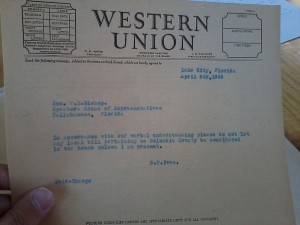Obsolete Printing Technologies: The Telegram –
Have you ever received a telegram? I was just thinking about it this week, and realized that I have never even seen a telegram delivered to someone I know. It is funny how every generation has technologies that they grow up with, and as each new batch of technology arrives the last generation becomes obsolete. It happens faster now in this age of technology, but if we think about the number of obsolete printing technologies there are we can see how this trend is nothing new.
The History of the Telegram
The earliest version of the telegraph telegram was a non-electric device that was invented in 1794. This version only worked as a ‘line-of-sight’ device. The telegram as we know it today was developed by Samuel Morse in 1835. Morse developed the system of dots and dashes that we recognize as Morse Code. He used an electro-magnet to emboss the symbols on long strips of paper. The first message traveled from Washington DC to Baltimore. It was only 40 miles, but such a big deal. Mind boggling when you think of the messages you can send on your smart phone, isn’t it? The invention of the telephone in 1877 was considered a rival technology.
How the Telegram Works
Telegrams were sent by transmitting a signal from one operator to another, and were read by a telegraph operator. Most telegraph operators transmit using Morse Code. Many words are written in abbreviated form and some words are even skipped altogether. Sentences end with the word stop instead of a punctuation mark. An operator transmits the message and the receiving operator transcribes the message so it can be conveyed to the recipient. Telegrams were often used for the delivery of critical information, like a death during war time. The ‘telegraph boy’ was a dreaded sight in many neighborhoods.
What Came Next?
Telegrams were an important technology but have been overshadowed by newer, faster inventions. The telephone was a fast and easy way to get a message to someone and didn’t require you to go to a telegraph office. Of course, many years ago, a lot of households did not have phones. Sometimes a telegram was the only way to get a message out there in a timely fashion. Computers, cell phones, fax machines and smart phones have overshadowed more obsolete printing technologies, and many telegraph offices have been phased out. Western Union started scaling back in the 1970′s as newer technologies developed. Western Union sent its last telegram on January 27, 2006. You can still send a telegram but it bears little resemblance to the days of old. Today’s telegram is accessed over the Web and costs $25.00 plus per word. A pretty costly message, I would say.
We will always see technologies fade away as newer, faster, shinier advances are made. That doesn’t mean the old versions are not good, just that something better has been discovered; so appreciate your technologies today, before the technology is replaced with something new.
Connect with Janelle


